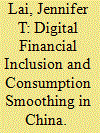| Srl | Item |
| 1 |
ID:
116514


|
|
|
|
|
| Publication |
2012.
|
| Summary/Abstract |
This paper provides a fundamental study of China's consumption and output fluctuations. The most recent literature reports that, in the post-1978 period, detrended consumption is significantly more volatile than detrended output in China. This indicates the inability to impose consumption smoothing. However, in those previous studies, consumption of durables, which has some features of capital, as discussed in the real business cycle literature, was not separated from private consumption. This paper is the first to estimate consumer durables for China and their service values following the method introduced in Cooley and Prescott (1995). We adjust the consumption measure to make it consistent with the real business cycle literature, and find that consumption of durables is much more volatile than output, but non-durable consumption is less volatile than, and less correlated with, output that provides evidence that supports consumption smoothing in China.
|
|
|
|
|
|
|
|
|
|
|
|
|
|
|
|
| 2 |
ID:
171881


|
|
|
|
|
| Summary/Abstract |
In this paper, we investigate the effect of digital nancial inclusion (DFI) on household consumption smoothing in China. We use four waves of the biennial China Family Panel Studies from 2010 to 2016, during which time DFI has signicantly developed alongside nancial technology across China. We split household income shocks into permanent and transitory components, and evaluate if DFI may help households to buffer against these shocks. We nd that households are not able to insure against permanent shocks to income, but they can smooth approximately 70 percent of transitory shocks to income. We also find that DFI has diminished households’ ability to insure against transitory income shocks. This is partly because online purchase may lead to the oversensitivity of consumption to income. In addition, we nd that contrary to DFI, traditional nancial sector development contributes to better household consumption smoothing against transitory income shocks
|
|
|
|
|
|
|
|
|
|
|
|
|
|
|
|